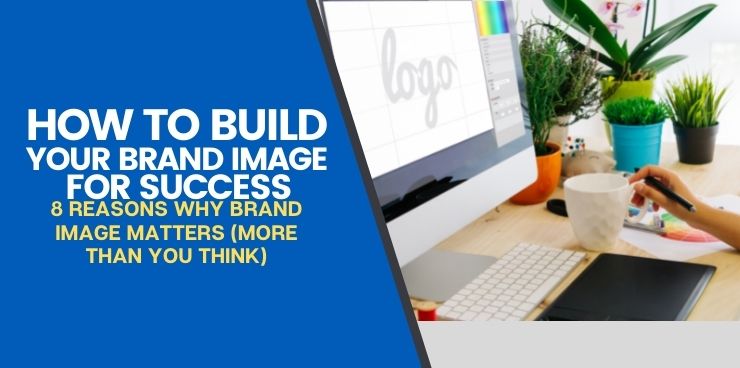Do you know what your brand image is? If you don’t, your customers don’t either.
To succeed as a business, your brand image needs to be consistent. It should also align with your company’s core values.
You could be an existing company or you might be a new brand. Regardless, brand image needs to be at the top of your marketing to-do list.
Nowadays, it is more than just your logo and how your website looks. It is your brand perception to customers.
What is Brand Image?
Let’s put it simply. Brand image is your company’s personality and reputation.
When you think about your brand image as a reputation, you have to think about how consumers perceive it.
You might have an idea of what you want your brand to be. But that can blind you. Instead, ask yourself what it really is.
Think about a company you love. Why do you love it? What does it say about who you are and what you stand for?
As a business owner, it defines your mission, vision, and values. This affects the customer experience, which you want to be overwhelmingly positive.
It fluctuates depending on external factors. This is why your branding ideas should be relevant to the brand image you want.
Additionally, brand image and brand identity are different. Brand image is more brand-centric, where brand identity is an extension of it.
Traditional brand identity begins with a name and logo design. It is how you think of your business. Brand image extends beyond these to encompass a brand’s personality and tone of voice. It is what everybody else thinks of your business.
Read on for more reasons brand image matters and how it affects your brand reputation.
Why is Brand Image Significant for Any Organization?
Customers are pickier than they used to be. Don’t think of this as a burden, though. Think of it as an opportunity to grow.
They want to feel like they matter. They look for experienced and answers, not just marketing campaigns and products. They want your brand to reflect that.
Because of this, brand image matters more now than it ever has. You don’t have to believe us, just ask Google about brand image and brand reputation.
The advent of search engines allows potential customers to find out what others think of your brand. Even if you are an underground, unadvertised company, people will be able to find almost anything they need to know.
Customers can now learn about your brand before they ever reach for your product or service. This means that your advertising phase and beyond is paramount to brand success.
They want to feel like a part of something bigger when they choose you. So be bigger, be better and grow brand awareness.
Why Does Your Brand Image Matter?
Here, we have eight reasons why your brand image matters more than you think. These are probably reasons you didn’t even think of until now.
It shouldn’t be something you focus on because it’s popular right now. You want to last in your niche market.
You Need the Presence
Imagine that you are a customer. You search online for a new cellphone. There are so many tech companies out there that already offer a wide array of cellphones. You start to get overwhelmed. You need some help.
If you establish your company as a dominant presence in a whirlwind of options, you are ahead of the game.
However, you can’t do that without a brand image.
You want people to want what you provide. You want them to see you as a brand that stands out from the competition. A presence makes it easier for them to remember when they need something.
You can accomplish this through a strong brand identity. This could include your logo, website layout, and more.
 It Builds Credibility
It Builds Credibility
You need to be a credible and solid company. Like we said, your reputation is at stake.
So capitalize on brand consistency. This includes the look and feel of your product. Tying in a brand image will make it easier for customers to trust your brand.
A consistent product or service means that you deliver quality results every time. That boosts the credibility of your brand image. Consumers want to be sure that they can rely on you for their own success.
Then, they are more likely to stick around. A credible image lets them know they’re getting what they expect from your brand. It may even make them feel like they’re an integral part of your team.
Credibility means you will stand out in their minds. And the more brand credibility you have, the fewer incentives you need to offer for consumers to buy what you sell.
It Builds Trust and Loyalty
You want a loyal customer core. How do you get one? Essentially, you need to be trustworthy. Trustworthy brands generate supportive customers. They are more eager to post positive comments and glowing testimonials.
In turn, that leads to frequent purchases from brand loyalists. It brings you brand advocates who can help spread the word about your brand reputation. They use personal recommendations and social media posts to bolster your image.
It Increases Brand Recognition
Brand positioning is how your company’s products and services measure up to the competition.
You position yourself favorably when you take advantage of brand recognition. How do you stand out within your industry?
The more recognizable your products are, the higher your ROI.
We give you more solid examples later, but let’s think about some recognizable brands right now, too.
Take Google, for example.
Google changes their logo depending on current events or holidays.
When they edit over their original multicolored logo on their homepage, you can still recognize that it’s their brand.
How do you prioritize brand recognition?
It Can Develop Brand Awareness Effortlessly
Brand awareness is another facet of brand recognition.
You always hear people spout off “it’s not a popularity contest!” But with brand image, it kind of is.
The more popular you are, the more customers are aware of your brand. This fosters a strong brand image. This is cyclical because when you have a strong brand image, you naturally attract more brand awareness.
It Increases Revenue
This goes without saying, but we’re going to say it anyway for the sake of clarity. When you have a strong brand image, your revenue can shoot way up.
Brand image is closely tied to brand loyalty. When you have loyal customers, they buy your brand’s product or service over any others in the same niche.
This duo brings about a monetizing mesh.
It Builds a Loyal Customer Base
A loyal customer acts as a sort of brand ambassador. When you have a team of consumers who promote your brand, others want to follow suit. It causes a multiplying effect that fuels brand loyalty.
This chain reaction builds and builds. If you play your cards right, you retain those loyal customers into an essential core.
Word-of-mouth marketing is the strongest form of marketing, period. It’s so powerful that it can catapult any business to new heights. Your brand’s image thus makes or breaks your company.
Lastly, it Creates a Lasting Impression
What is your reputation like? What do customers think about your brand?
In this highly competitive environment, brand image is your most valuable asset. It’s like a first impression that doesn’t go away easily. This is why brand loyalty is so essential for businesses.
How you brand yourself and how you market your brand should leave no room for the imagination. Today’s consumers know how to pinpoint your strengths and weaknesses. So make sure that your brand image highlights your strengths, not your weaknesses.
If you keep your brand promise, you cultivate a positive and lasting impression. If you break those promises, you leave behind the impression that you couldn’t care less. In this aspect, your success as a business is up to you.
Examples of Good Brand Image
What companies should you model your brand after? We have four examples of a good brand image here.
Colgate
You hear the name “Colgate.” You might automatically think of the shiny red toothpaste tube with pearly white lettering. If so, that’s because Colgate does an excellent job of sustaining its brand image.
They also have widely watched commercials on cable television. Most American consumers see the brand and think of clean, strong, and white teeth.
This is brand recognition in action.
Tiffany & Co.
“Tiffany blue.” That’s a common color now.
Every time you see that robin’s-egg blue color, you are probably more inclined to call it “Tiffany blue” instead.
It sounds better, it looks better and it evokes a positive connotation.
This is what Tiffany & Co. wants you to think of their jewelry, too. As it turns out, most people probably do. They successfully market quality jewelry pieces to their customer base.
They are a headliner in their market. Their brand image has a lot to do with effortless brand awareness.
Supreme
Have you ever heard of “hype beasts” or “hype branding?”
The streetwear company Supreme pretty much invented it.
It leaves its consumers with a brand name that’s catchy and a brand image that looks cool on anyone who wears it, just by association.
Supreme builds massive amounts of revenue. They often sell out of their coveted pieces. They have pop-up events in major cities with lines curving around blocks on end.
What is it about them?
It’s their brand image. They have a limited amount of products for each drop and they target their loyal customer base. They are credible and collaborate with other well-known and well-respected companies.
Consumers also trust that the price they pay will reflect the quality of their products. Their brand identity is also distinct, with a simple and powerful logo.
Rolls-Royce
When you think of Rolls-Royce, you might think of luxury and wealth.
They are pricey, but their motto and brand promise stay the same: “Take the best that exists and make it better.”
They pride themselves on their brand image and they create an emotionally appealing brand to consumers.
Rolls-Royce does this when they create a lasting impression, stay in the loop with technological developments and build loyalty within their demographic.
Examples of Bad Brand Image
So now you know what the prime examples are for companies that build a good brand image. But what are some examples of what not to do? Take a look below for some examples of bad brand image.
The Travel Channel
The Travel Channel is known for its quality documentaries and travel-related cable content.
But you may be asking yourself: why haven’t I seen them around for a while?
Actually, you have. In 2018, they “rebranded” and came out with a new logo. It used different colors and omitted all vowels. They are now called “trvl.”
This and their new content confused viewers. They had trouble understanding the brand. What was once a trusted brand now seems like a complete disaster.
Heineken – “Lighter is Better”
Heineken is a longstanding beer brand. But they broke consumer trust when they put out their light beer commercial in 2018.
In the ad, you see three Black people and a bartender. The bartender slides the bottle of Heineken Light past all three Black bar patrons and to a woman with far lighter skin.
It then reads “Sometimes, lighter is better.”
It’s easy to see why consumers protested Heineken after that. They used an insensitive tagline with an even more insensitive image. Once-trusting brand ambassadors criticized the racist campaign and withdrew their brand loyalty.
 Burger King’s Unsatisfying Satisfries
Burger King’s Unsatisfying Satisfries
You’ve heard of Burger King. But you might not remember their failed “Satisfries” launch because so few locations still have them on the menu.
The Satisfries launched as a “healthier” alternative to regular french fries. However, they did not promote this in a cohesive way. It left customers confused.
This left them unsatisfied with Burger King’s brand and service, regardless of the new product.
It is also confusing when you consider that Burger King is not a “healthy alternative” fast food franchise to begin with.
GAP’s Logo Change
In 2010, GAP changed their logo. It only lasted a week before they changed it back to the original.
When they changed their logo, they ignored their brand identity. Some customers thought it was “tacky.” Almost all of them jumped in to add their opinions. It was a resounding “no” on the change.
Word-of-mouth again proves to be a huge factor in company success here.
Conclusion
Now you know how much brand image matters. But it can still be hard to know where to start to improve or build your own. That’s why we’re here to help. At Selling Revolution, we help brands become better.
We can start with brand identity and brand image building. Check out our blog for more tips.
To learn more about how we can build a brand you and your customers love, book a quick call with us today.


 It Builds Credibility
It Builds Credibility
 Burger King’s Unsatisfying Satisfries
Burger King’s Unsatisfying Satisfries